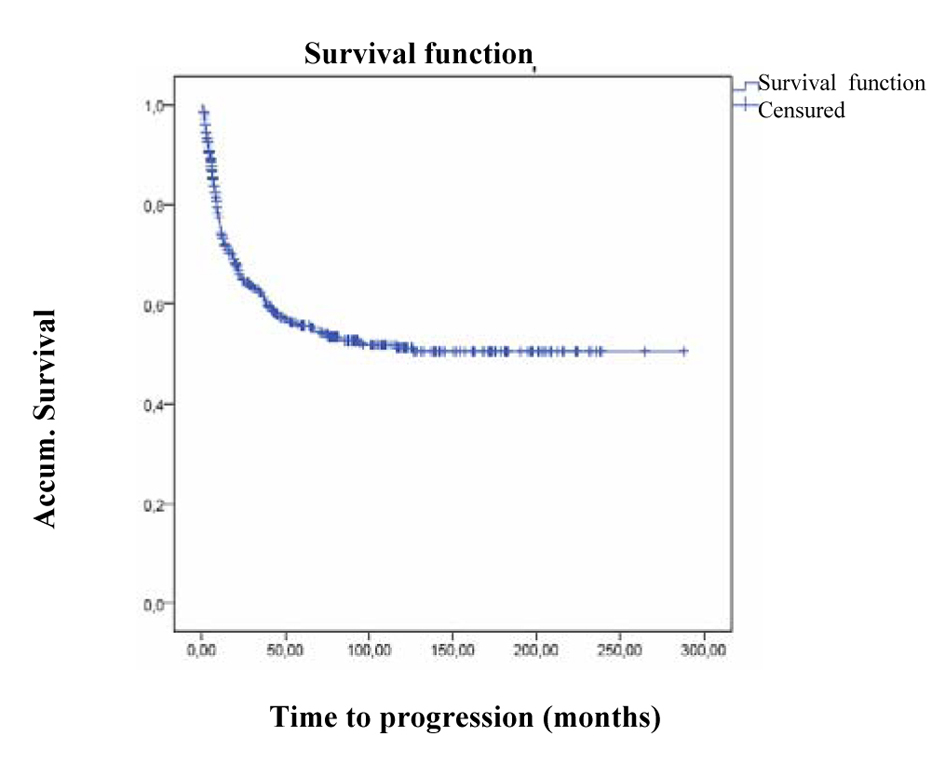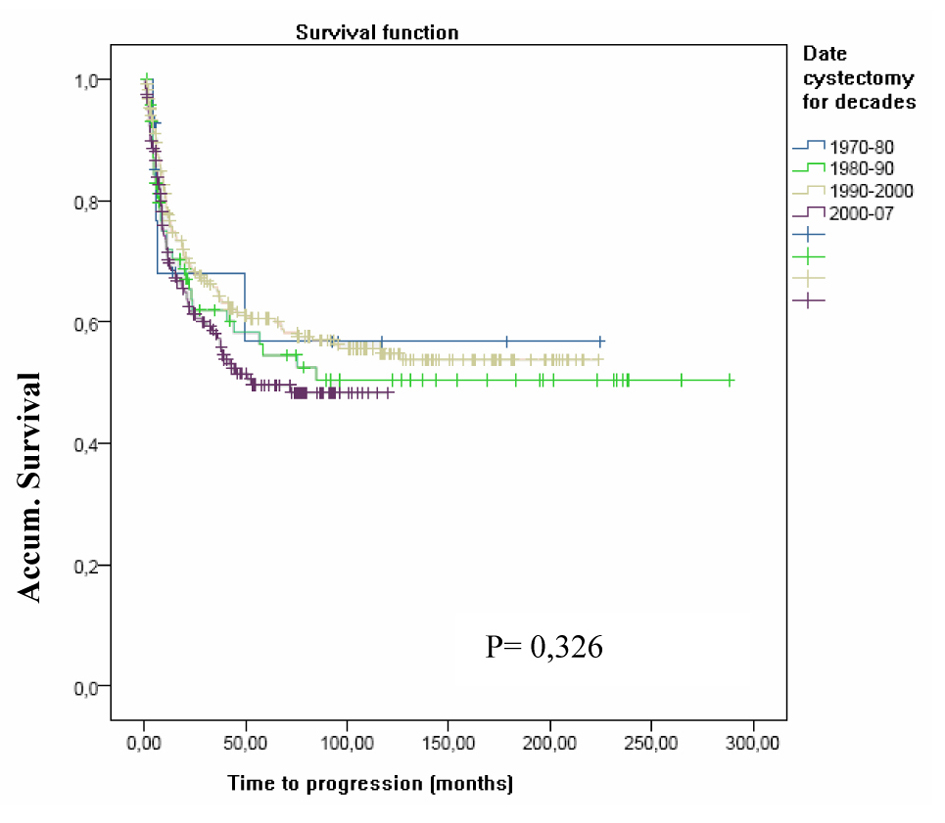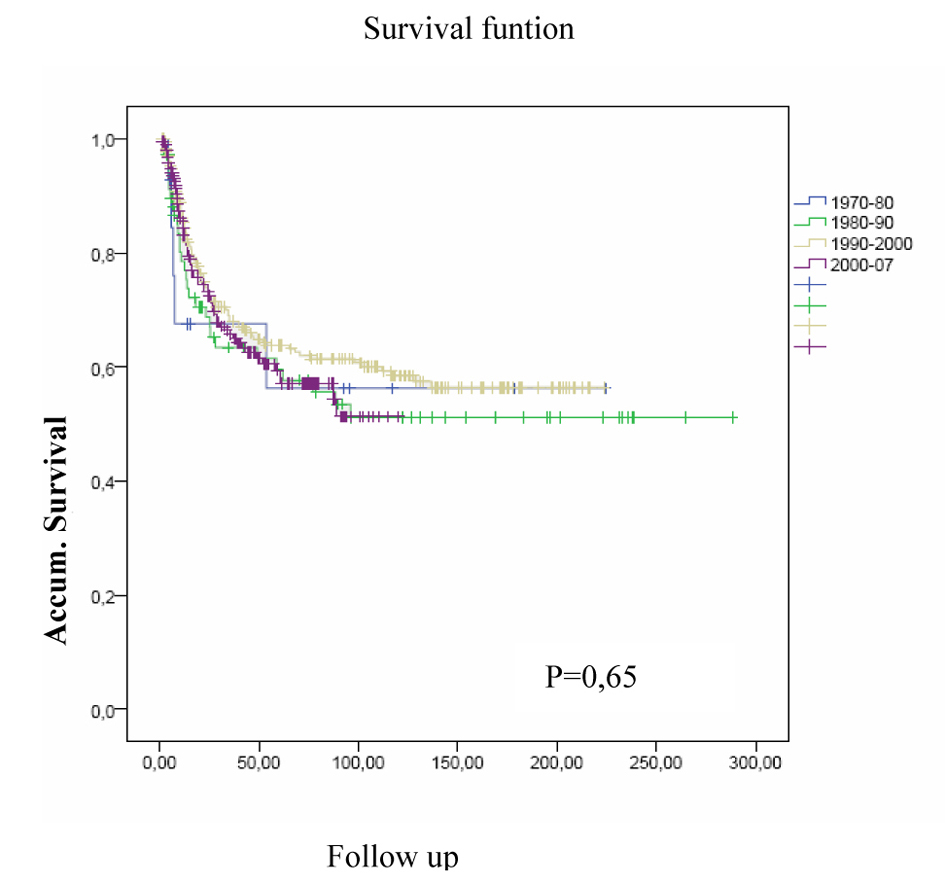
Figure 1. PFS in n = 563.
| World Journal of Nephrology and Urology, ISSN 1927-1239 print, 1927-1247 online, Open Access |
| Article copyright, the authors; Journal compilation copyright, World J Nephrol Urol and Elmer Press Inc |
| Journal website http://www.wjnu.org |
Original Article
Volume 2, Number 1, June 2013, pages 1-9
Have Progression-Free Survival and Cancer-Specific Survival in Bladder Tumors Changed in Recent Decades?
Figures



Tables
| Pre-Cystectomy Variables | Peri-Cystectomy Variables | Post-Cystectomy Variables |
|---|---|---|
| TURBT: Transurethral resection of bladder tumour; SBC: Superficial bladder cancer; UC: Urothelial carcinoma; UUT: Upper urinary tract; CT: Chemotherapy; BC: Bladder cancer. | ||
| Gender | Transfusion | Hospital stay |
| Age | Type of catheterisation | Follow-up |
| Smoker | Ureteral reimplantation | Adjuvant CT |
| Alcohol | Pathological stage (pT) | Major perioperative complications |
| Risk occupation | Tumor grade | Minor perioperative complications |
| Living environment | Lymph node involvement (pN) | Late-onset complications |
| Comorbidity | Presence of CIS | Tumor recurrence in UUT |
| Clinical presentation | P53 | |
| Clinical stage of TURBT | Anatomical pathology Terminal ureter | |
| History of SBC | Ureterectomy | |
| History of UC in UUT | Anatomical pathology type | |
| Neoadjuvant CT | Organ confinement | |
| Tumour in UUT concomitantly with BC | ||
| Type | N° pacientes(% respecto a N = 563) | ||
|---|---|---|---|
| Major perioperative complications (< 30 days). | |||
| Early reoperation (bleeding, peritonitis, occlusion) | 12 | (2.1%) | |
| Surgical | Rectal injury | 5 | (2.3%) |
| Evisceration | 8 | ||
| Fistulas (with action) | Intestinal leakage | 11 | (2.1%) |
| Enteroneovesical fistula | 1 | ||
| Multi-organ failure | 2 | (0.3%) | |
| Infectious | Sepsis | 9 | (1.7%) |
| Pseudomembranous colitis | 1 | ||
| PT | 20 | (3%) | |
| Cardiological | Acute MI | 2 | (1.2%) |
| Acute pulmonary edema | 5 | ||
| Neurological | CVA | 1 | (0.1%) |
| Respiratory | Respiratory failure | 2 | (0.5%) |
| Bronchoaspiration | 1 | ||
| Digestive | Liver failure | 3 | (0.5%) |
| Perioperative mortality | 36 | (6.4%) | |
| Type | N° patients (% of N = 563) |
|---|---|
| Prolonged ileus | 47 (8.3%) |
| Abscess (with action) | 11 (1.9%) |
| Infected wound | 26 (4.6%) |
| Urinary leak (with action) | 15 (2.6%) |
| UTI with repercussion, pyelonephritis | 10 (1.7%) |
| DVT | 5 (0.8%) |
| Cardiac arrhythmia | 1 (0.1%) |
| Pneumonia | 26 (4,.6%) |
| Metabolic acidosis | 9 (1.5%) |
| Upper GI bleeding | 14 (2.4%) |
| Cholecystitis | 1 (0.1%) |
| Type | N° pacientes (% de N = 563) | ||
|---|---|---|---|
| Repair of the derivation | In Mainz I | 1 | 9 (1.5%) |
| Hautmann neobladder repair | 1 | ||
| Reparacion estoma Bricker | 7 | ||
| Reconversion of the derivation | To the colonic conduit | 1 | 7 (1.2%) |
| Reconversion to Bricker | 6 | ||
| Lts reservoir (with action) | 23 (4%) | ||
| Ureteral anastomosis stricture (with action) | 46 (8%) | ||
| Ureteral anastomosis stricture (with action) | 18 (3.1%) | ||
| Retentionist neobladder (self-catheterism) | 12 (2.1%) | ||
| Reintervention due to occlusion | 7(1.2%) | ||
| Eventration: mesh | 4 (0.7%) | ||
| Parastomal hernia repair | 1 (0.1%) | ||
| Variable | B | SE | Wald | Gl | P | O.R | 95% IC para Exp (B) | |
|---|---|---|---|---|---|---|---|---|
| Inferior | Superior | |||||||
| Pathological organ confinement | 1.077 | 0.283 | 14.445 | 1 | 0.000 | 2.936 | 1.685 | 5.117 |
| Nodal involvement | 0.861 | 0.214 | 16.219 | 1 | 0.000 | 2.365 | 1.556 | 3.595 |
| Variable | B | SE | Wald | gl | P | O.R | 95% CI for Exp(B) | |
|---|---|---|---|---|---|---|---|---|
| Inferior | Superior | |||||||
| Pathological organ confinement | 0.906 | 0.233 | 15.097 | 1 | 0.000 | 2.475 | 1.567 | 3.909 |
| Nodal involvement | 0.849 | 0.192 | 19.466 | 1 | 0.000 | 2.336 | 1.603 | 3.406 |
| Perioperative mortality and % of complications in radical cystectomy | ||
|---|---|---|
| Referentes | Mortality | Morbidity |
| Lowrance et al [7] | 1.7% | 41% |
| Skinner et al [10] | 2.4% | 28% |
| Lee et al [11] | 1.6% | 45% |
| Stimson [13] | 2.1%(days) y 6.9%(90 d) | 26% |
| Chahal [14] | 8.6% | 25.6% |
| Frazier et al [21] | 2.5% | 31.9% |
| Freiha [22] | 3.3% | 41% |
| Stein et al [23] | 2.5% | 28% |
| Hautmann et al [24] | 3.0% | 39% |